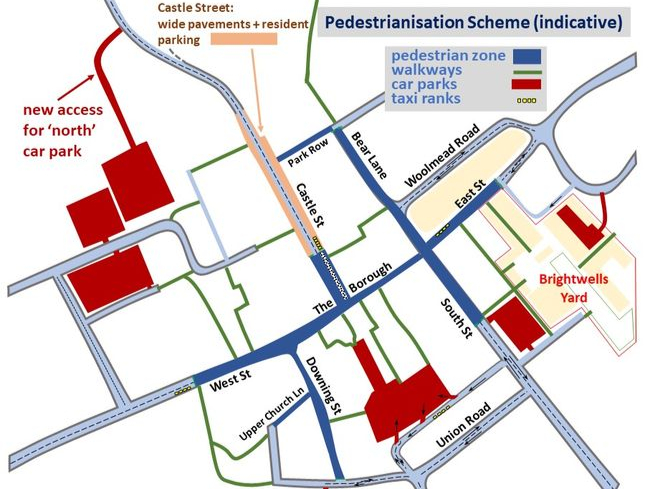In the July 7 edition of the Herald, I outlined the benefits of a pedestrian zone in Farnham town centre.
The street plan that was included shows one way that it might work. Other versions have been proposed by individuals and organisations, so this is not the only solution.
This article is a quick summary of the current situation. The big decision for people in Farnham now is:
Do we accept the proposals Surrey County Council are putting forward this summer? They are certainly a step forward. Or:
Do we ask Surrey to come up with a more imaginative plan, or road map, which would lead to a pedestrianisation scheme in the foreseeable future? Current proposals seem to be offering no path to that end game.
These are not easy decisions for the authorities. In particular, it is very difficult to predict how people would adapt to changes and their willingness to support change.
These are questions I have put forward in the online survey, so please take part so we have the widest understanding of local views.
Current Surrey County Council (SCC) proposals
During the summer consultation, you will see proposals for changes to the town centre road system. These will relieve some of the problems and provide more pedestrian space, but they come with inevitable downsides.
There will still be a significant traffic flow through the central area.
Do go and visit the exhibitions and give SCC your views. If you think the proposals are not imaginative enough, do say so.
Farnham Infrastructure Programme – give us better solutions
We all know the main challenge to making this scheme happen is the presence of the main A287 route through the centre of the town.
Closing this route will mean most through traffic will need to go to the east of the town, meaning more traffic using the A3016 in the Upper Hale area.
Until we see some traffic survey figures (yet to emerge), we don’t know how much traffic coming down Castle Street is heading for the town centre as opposed to going through.
We also don’t know how much of the through traffic is non-local, ie should really be using other routes such as the A331 Blackwater Valley route.
All we do know is that if FIP does not find a way of resolving the problems, then many people’s aspirations for a revitalised town centre will not be achieved.
Apart from not delivering the benefits of a pedestrianisation scheme, there could be significant downsides to the town-centre economy and the future of the conservation area.
I would hope that FIP, with active support from local people and the local councillors, would think further about finding solutions that will deliver pedestrianisation within the near future, and not, once again, defer it as an aspiration for the long term.
Main options
If the public says, in the summer consultation by SCC, that it still wants a pedestrianised town centre, then SCC should continue to try to find solutions to the highway problems.
Local opinion generally favours a new major road to the west of the town or somehow linking the A287 Beacon Hill area to the Six Bells roundabout area, on its way to the A31.
If SCC knew it had strong local support for this, then it would be in a better position to put forward a compelling business case for government funding.
In the meantime, FIP could implement some trial road closures – perhaps at weekends – to see how people react to a more pedestrian-friendly town centre, and how the traffic movements would adjust.
We would also see how people adapted their travel habits during these trials; once this happens, the negative impacts are often less severe than expected. Improvements for cyclists and bus services are needed to complement this.
We could support the changes being proposed by FIP at the moment, with hopefully a stronger commitment by SCC to progress from there to something substantially better in the foreseeable future.
Please take part in my survey so we get as much feedback on local views as possible: surveymonkey.co.uk/r/DS7JZTN
Farnham Residents councillor John Neale stood town as Farnham Town Council leader in April – his survey is independent of the official county council-run consultation.





Comments
This article has no comments yet. Be the first to leave a comment.